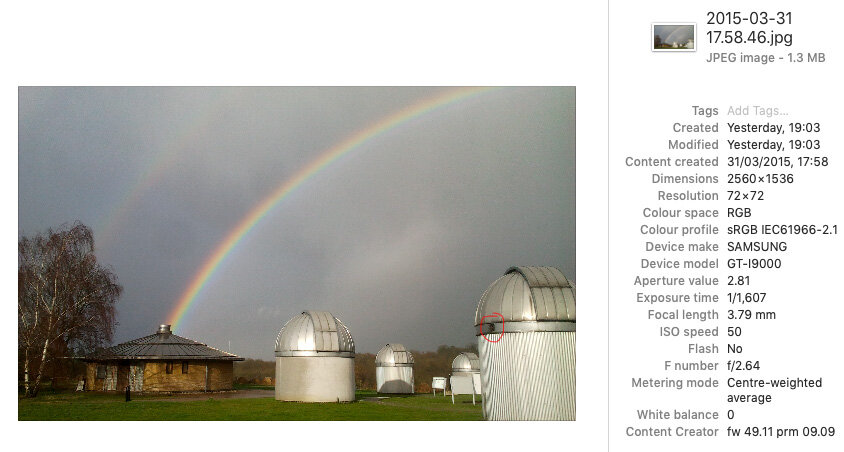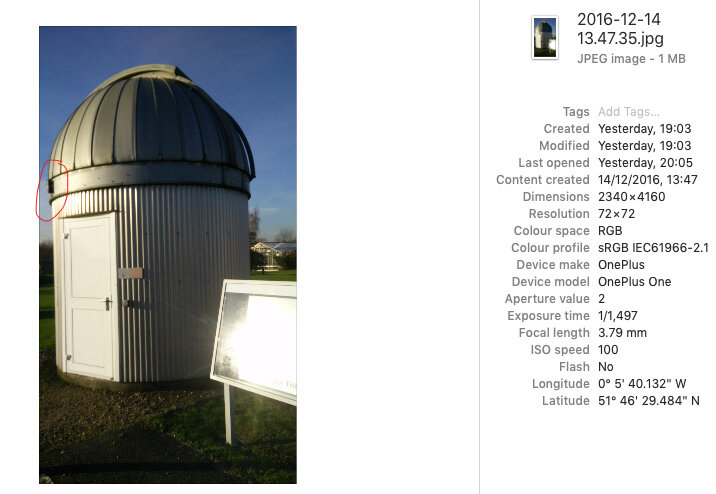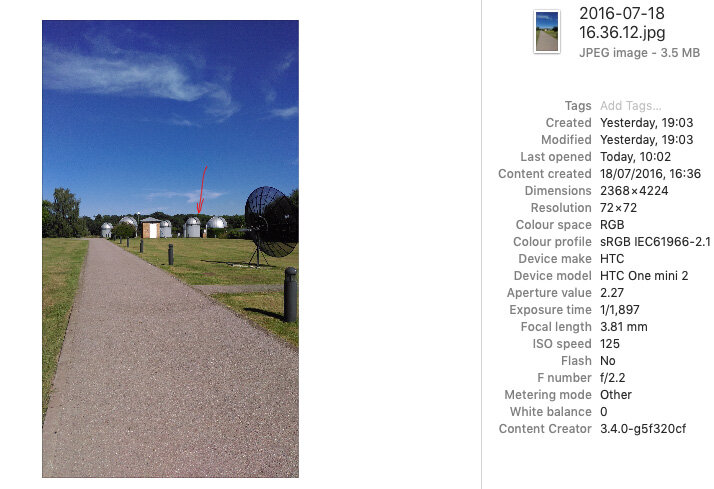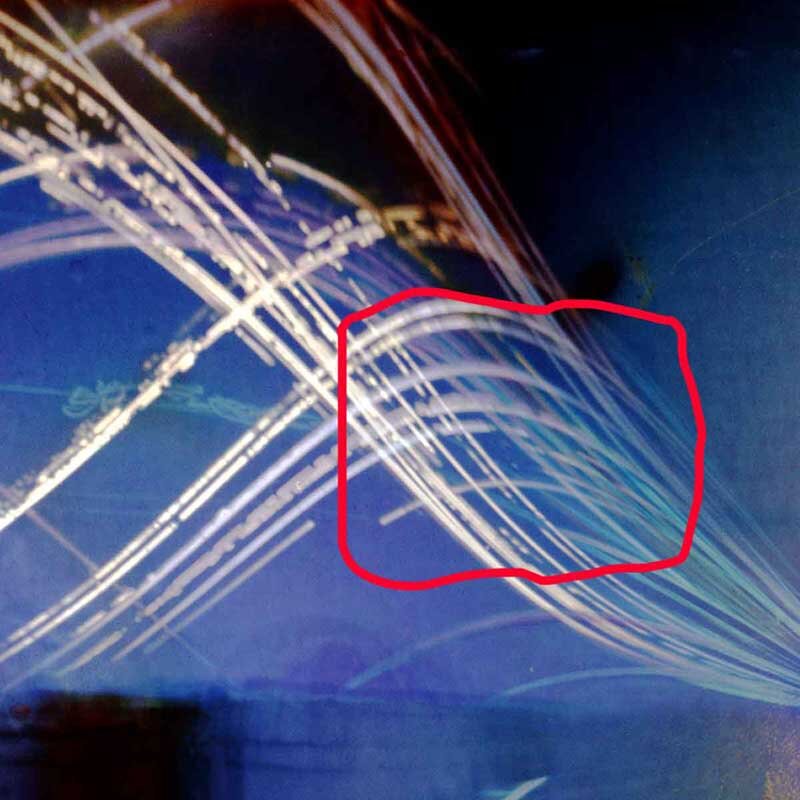“How can you prove ‘Perpetuity’ is a genuine 8 year long exposure?”
In the summer of 2012, I ‘harvested’ the pinhole cans for the ‘Bayfordbury 2’ series when my Masters course at the University of Hertfordshire came to an end. I was particularly pleased with the images that came out of two cans which had been attached to revolving telescope domes. In these, the sun trails became twisted because of the movement of the dome as different parts of the sky which were being examined by the astronomers. Even though I was no longer a student, the Observatory allowed me to carry on using their site for my work. It was the most ideal place where cameras can be left undisturbed. So I know that the start of the exposure was in the summer of 2012 but I didn’t take note of the exact date as this was just supposed to be a ‘moving pinhole’. As it turns out, the dome only moved at night and returned to the exact same position before dawn. So no movement was captured.
David Campbell photographed his working environment of the Observatory grounds over the years. These images were not taken as ‘proof’ for my pinholes as it was not my intention to do an extreme long exposure. But these images testify the timeline. In the slideshow below you can see the cameras in situ. David’s earliest photographs date from 2013 and his latest supporting evidence is from 2020. These clearly show both of them in situ on the telescope dome until 2016. At some point after this, the first pinhole (the failed one) was removed and only the remaining (8 year) pinhole is visible in subsequent photos until 2020.
“If the image is eight years old, why is the sky not white from all those overlapping sun trails?”
Even though the image survived an eight year exposure, it may not have captured eight years worth of sun trails. This could be due to several reasons; reciprocity failure, latitude, weather. Sometimes the pinhole aperture can get blocked by dirt but I do not believe this was the case.
The reciprocity failure was explained in the National Geographic article as follows;
“The downside of long exposures using traditional film methods is a reliance on chemistry of the photographic medium, in this case the paper, retaining its sensitivity to changes in the light before it hits a wall – rather like a saturated cotton wool pad that can no longer absorb water. This is known as reciprocity failure, and can result in colour casts, patches of lost detail, or simply no further changes in the image. While the eight year exposure stands regardless, Valkenborgh accepts that at some point the paper probably stopped recording detail – and that “it may not have 8 years’ worth of sun trails overlaying each other.” The man who found the camera attached to the dome, however, believes the camera may have captured a surprising amount of the exposure period. “The image was changing until at least 2018, as the gantry was not built until the end of 2017 and it is quite clearly defined,” says David Campbell, Principal Technical Officer at the Bayfordbury Observatory.” Simon Ingram, National Geographic.
Once the silver halides in the photosensitive paper react to light exposure, they darken. Normally, in wet darkroom processing, this is a latent image which only becomes visible through chemical processing. On long paper exposures, the sun trails become etched in and they are visible without chemical processing. But the light energy travelling through the pinhole was not proportional to the 8 year exposure time. I believe that, in the sky where you can see the sun trail arches, the silver halides reacted and darkened, but that at some point they may have become ‘inactive’. In the bottom part of the image it is much darker because less light photons hit the paper over the years. The landscape gets captured at a much slower rate as the light photons bouncing off the ground and into the pinhole aperture are less intense than the direct sun light which burns itself into the paper and becomes visible to the naked eye after as short as a one day exposure. Simply put, the sky and landscape exposed at different rates, the sky fast and the landscape slow. This is why details were being recorded in the lower part of the image until at least 2018 as the new-built gantry would suggest. At this time the recording in the top of the image may have slowed down or stopped altogether.
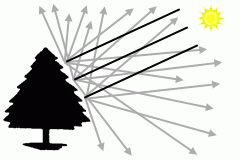
No light, no sight. We only 'see' when light photons hit an object and bounce around, to be picked up by our eye.
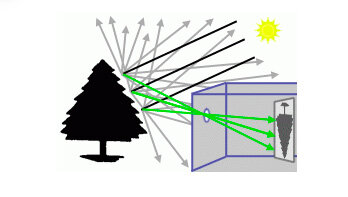
Photography makes it possible to capture images by making permanent those bouncing light photons on a light sensitive material.
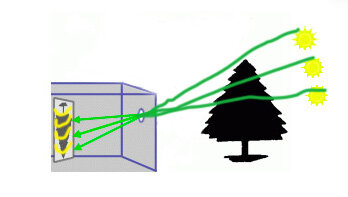
Pinhole photography allows direct sun light to burn into the light sensitive paper. The surroundings are captured slower because the photons have to bounce off objects before entering the pinhole aperture.
The gantry.
The images below show the viewpoint the pinhole had from where it was attached to the dome. The gantry, the steel structure housing the Observatory’s weather data equipment, was built at the end of 2017 and finished early in 2018. This is clearly visible on the 8 year old exposure. The fact that this has been captured at all proves that it was still ‘recording‘ in early 2018 and probably beyond.

The view
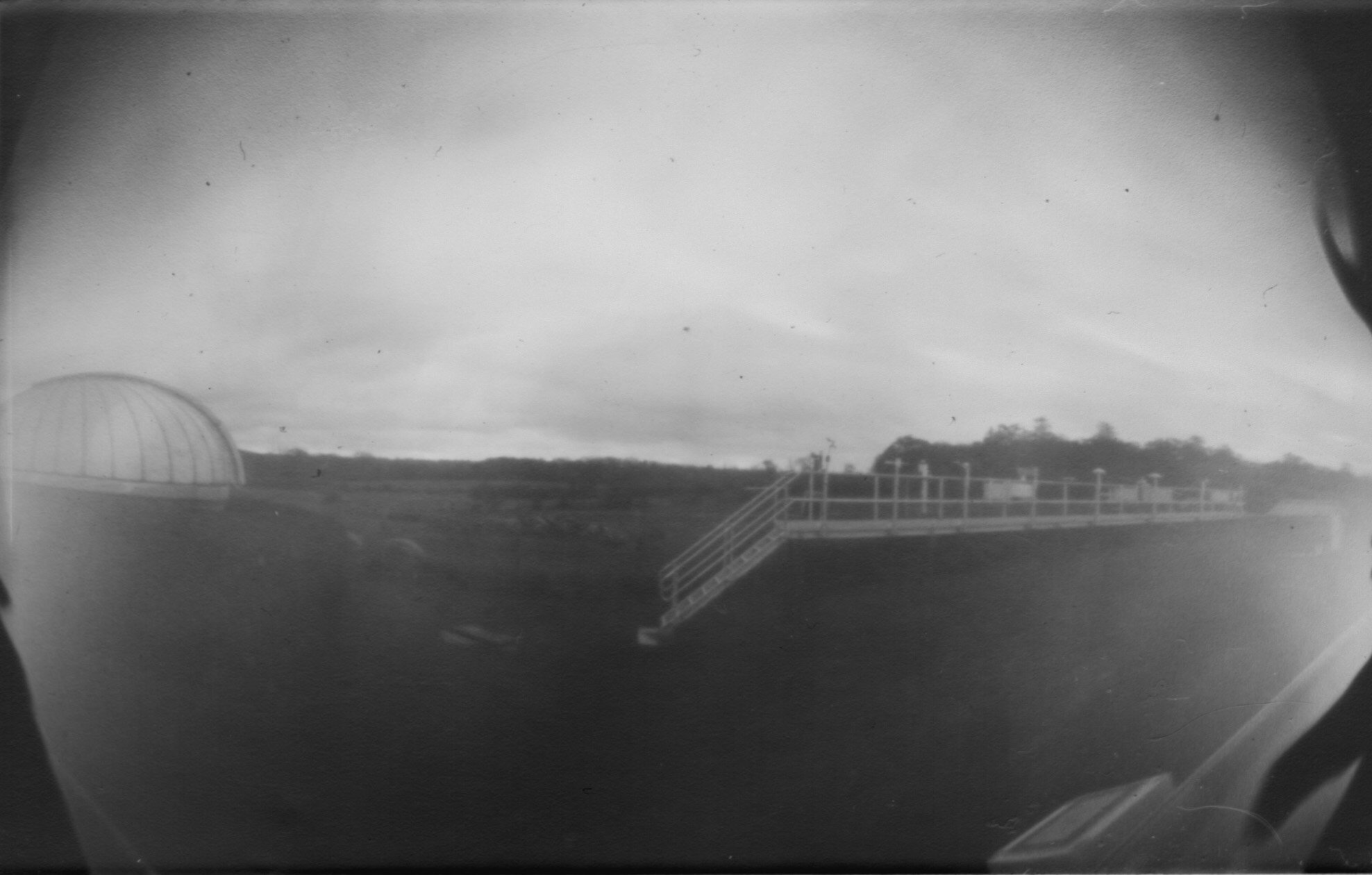
The view as seen through a pinhole camera
Pinhole image by David Campbell
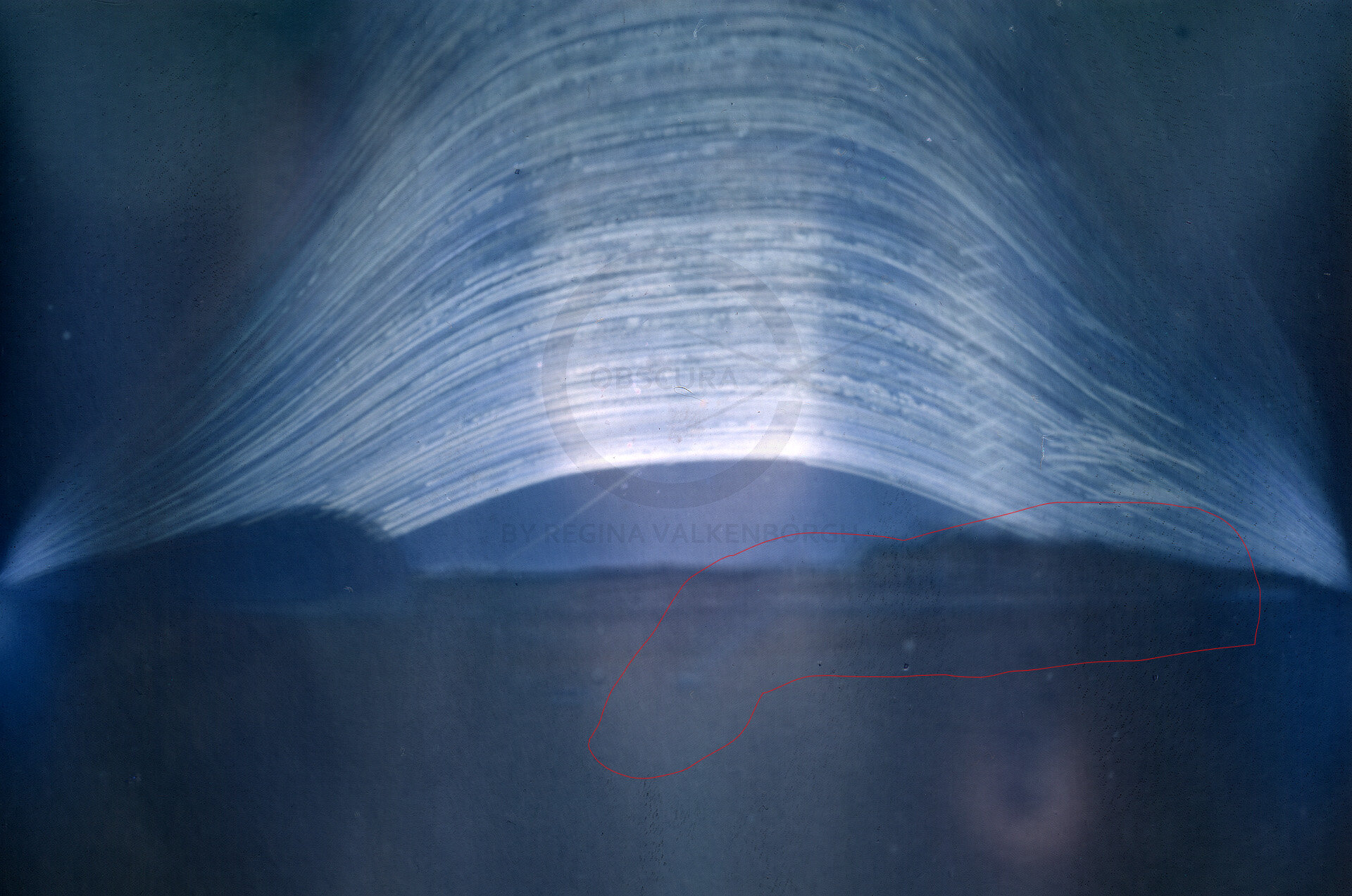
The gantry is clearly visible
“In the National Geographic article a crane was mentioned which is visible on Google maps. The odd lines on the right hand side of the solargraph can not have been produced by this kind of crane but may be produced by any kind of agricultural machine related to the round straw bales”.
The google maps image referred to here is from April 2019 (see below). There is no crane in the picture. The crane and machinery which was used to build the gantry is not visible on the Google image. The metal structure you see is the actual gantry and this was not built until end 2017-early 2018. This gantry, which is clearly visible on the 8 year pinhole image is proof that it was still ‘recording’ in 2018. The strange lines (circled in next image) are positioned directly above the gantry. This could suggest it was due to the crane which was used during the build of the gantry, but the uniformity of the lines suggest the possibility that they could be sun trails which were disrupted by movement of the dome.

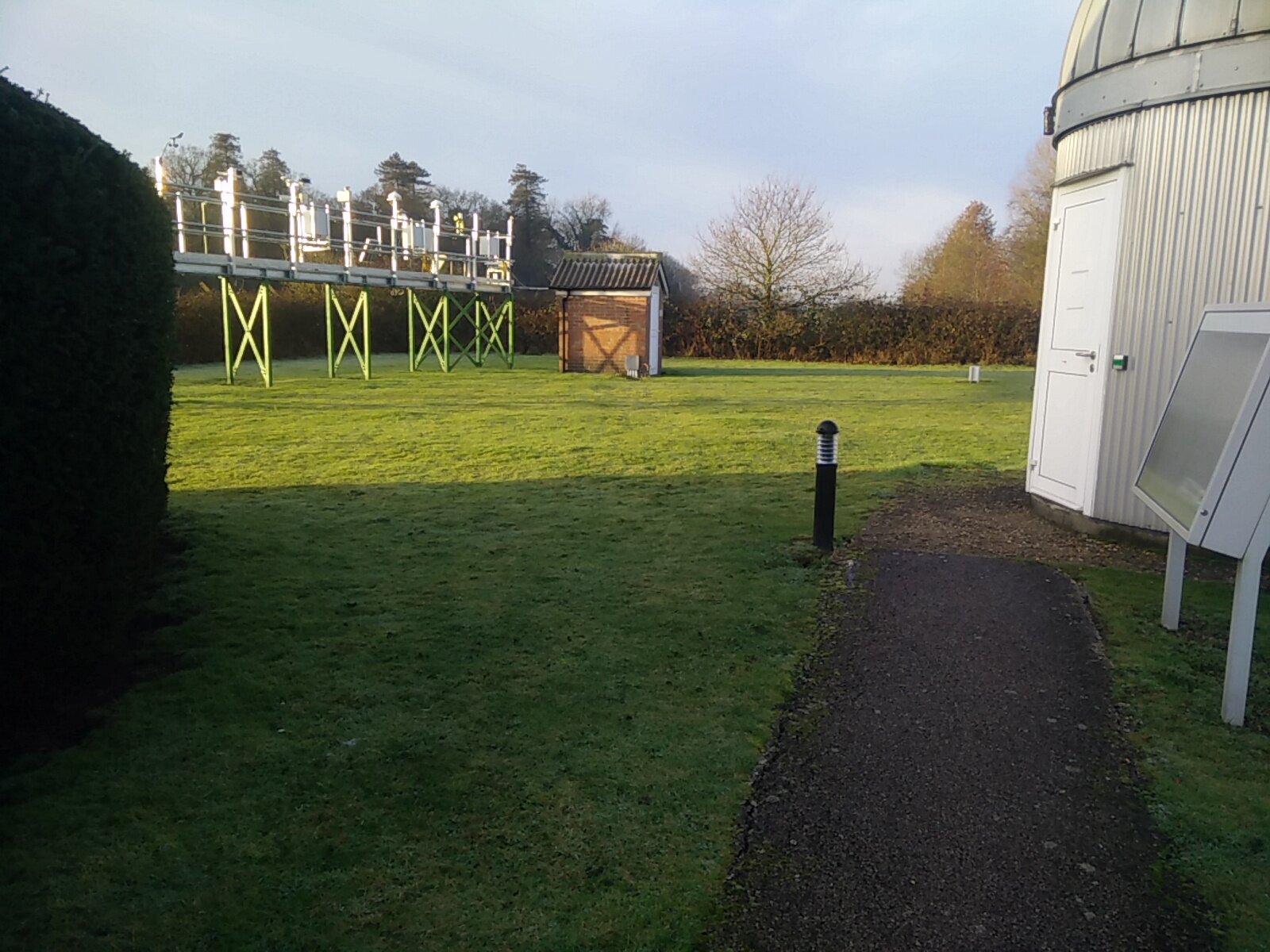
““A visual analysis of the ‘8 years exposure’ picture” by a reader.
I’m not entirely sure what the reader means by ‘anchor flanges’ but I use plastic cable ties to secure my pinhole cameras and yes, they could have caused the bulging if done too tightly. These cable ties can last up to 15 years and I have never had one fall off. The ‘12 lines’ circled on the right are positioned right above the gantry. I don’t think they are due to any agricultural machinery or building cranes, they are more likely due to the sporadic movement of the dome in the very beginning of the exposure, before the dome was re-assigned as night use only.
The colour digital image of ‘The view’ (above) clearly shows the gantry, circled on the right. The reader has wrongly assumed that the gantry and trees are straw bales.
Staggered solar lines effect.
Using the dome’s movement to cause disruption in the trails was my initial goal.
David Campbell explains: “The telescope dome that it was attached to was originally intended to move about during the day (in 2012 it had an atmospheric instrument rather than a telescope). The instrument was never really utilised as intended in the dome, and so the dome probably didn’t move very much whilst it was in there. Less than a year later in June 2013 a telescope was put into the dome instead. This meant that the dome would really only move during the night and return to (almost exactly) the same position by the time the sun rose, hence why the trails all largely appear as though the camera hadn’t moved, and the foreground is constant but blurred slightly laterally. There would be the odd time the dome moved during the day (maintenance, faults… etc) but maybe 99% of the time the camera was in more-or-less the same position over the 8 years”.
Below is a detail from a previous pinhole which had been attached to a moving dome and a detail of the strange lines in question on ‘Perpetuity’. This was the effect which I was trying to re-create. The solar trails get twisted and staggered as the the dome moves. If the domes moved briefly at the beginning in 2012, or for ‘maintenance and faults’, as David suggests, this may have caused the strange ‘12 lines’.
Pyranometer data simulations by David Campbell.
The simulations below were created using data from a ‘pyranometer’. This is a sensor that converts the radiation it receives into an electrical signal that can be measured. It is one of many pieces of weather equipment installed at the Observatory. David Cambell explains: ‘The position of the Sun in the sky was calculated when the pyranometer data suggested the Sun was visible, and this is plotted on the image as though it was projected through a pinhole camera of the same dimensions to the one used for the real exposure’. This made it possible to time sequence the data into separate years. And also to combine them into one single eight year frame.
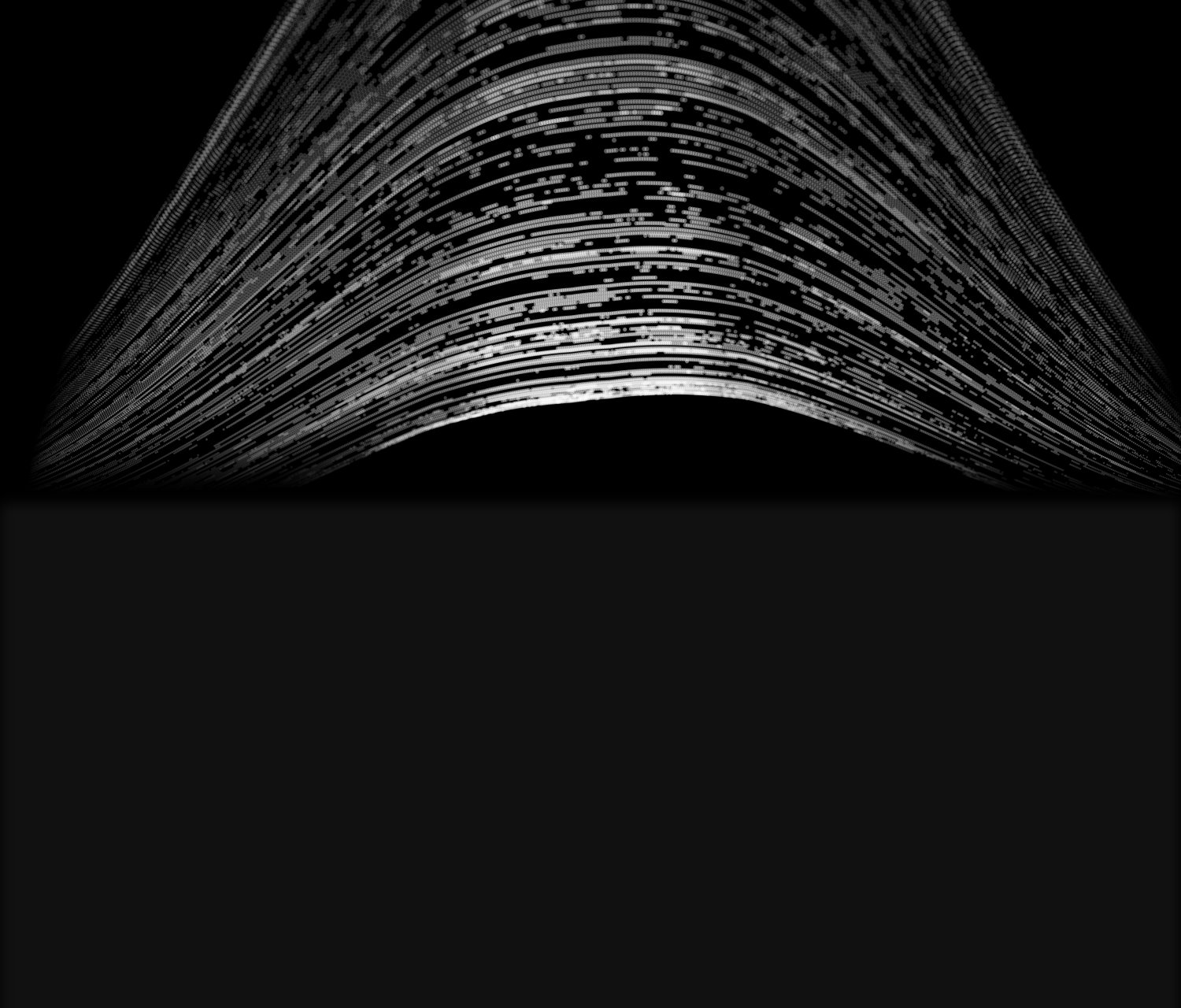
Summer 2012-Summer Solstice 2013
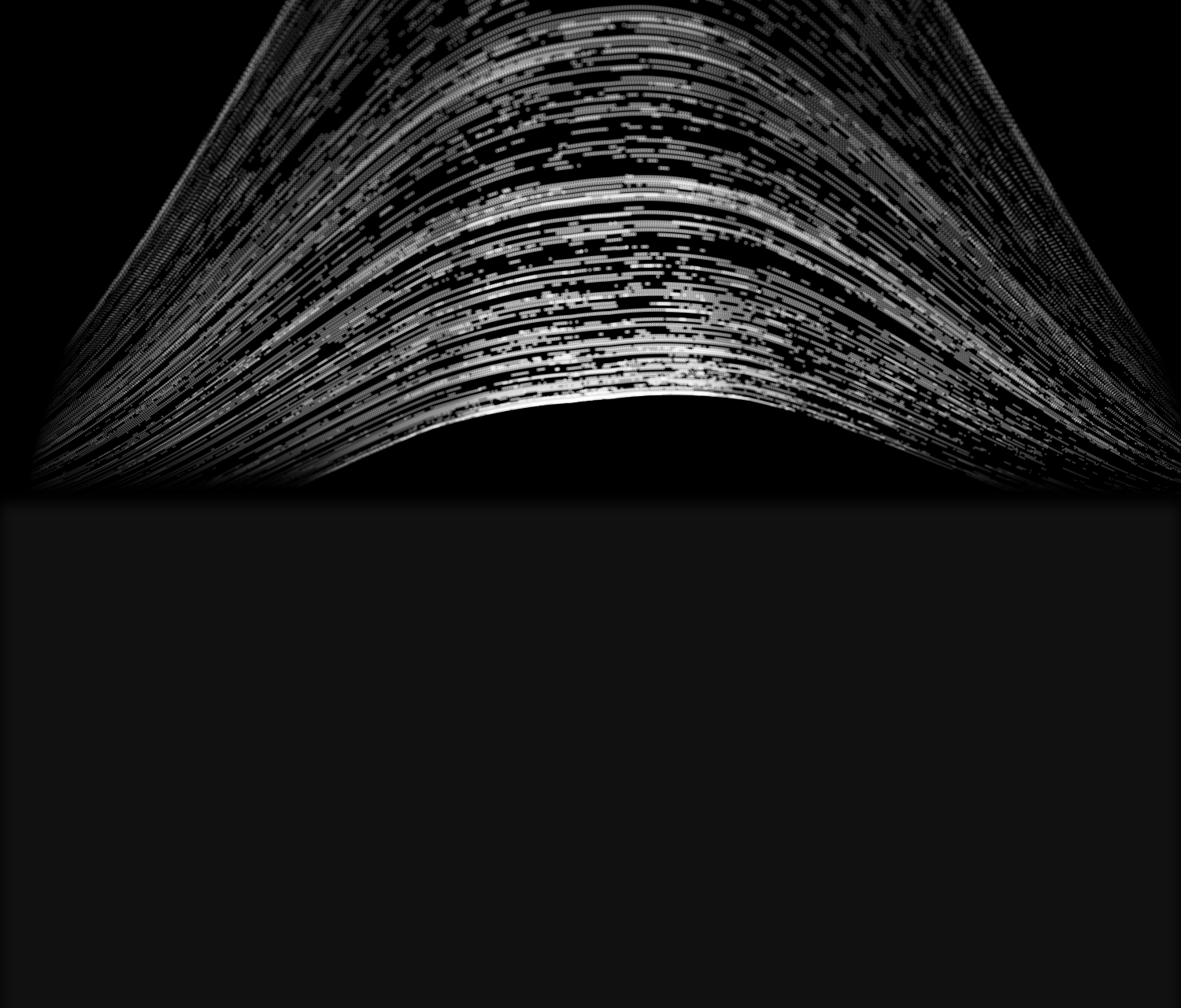
Summer Solstice 2013-Summer Solstice 2014
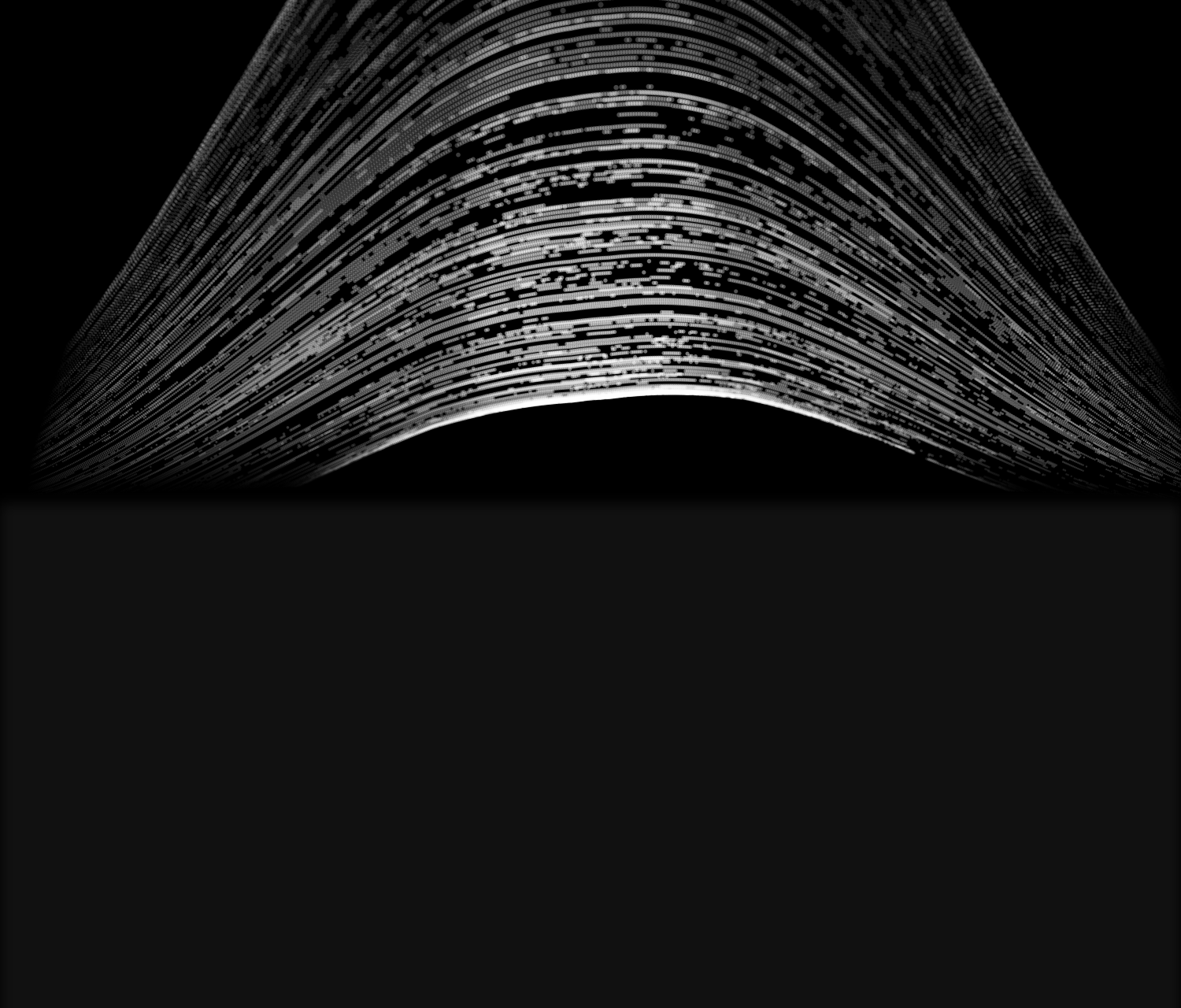
Summer Solstice 2014-Summer Solstice 2015

Summer Solstice 2015-Summer Solstice 2016
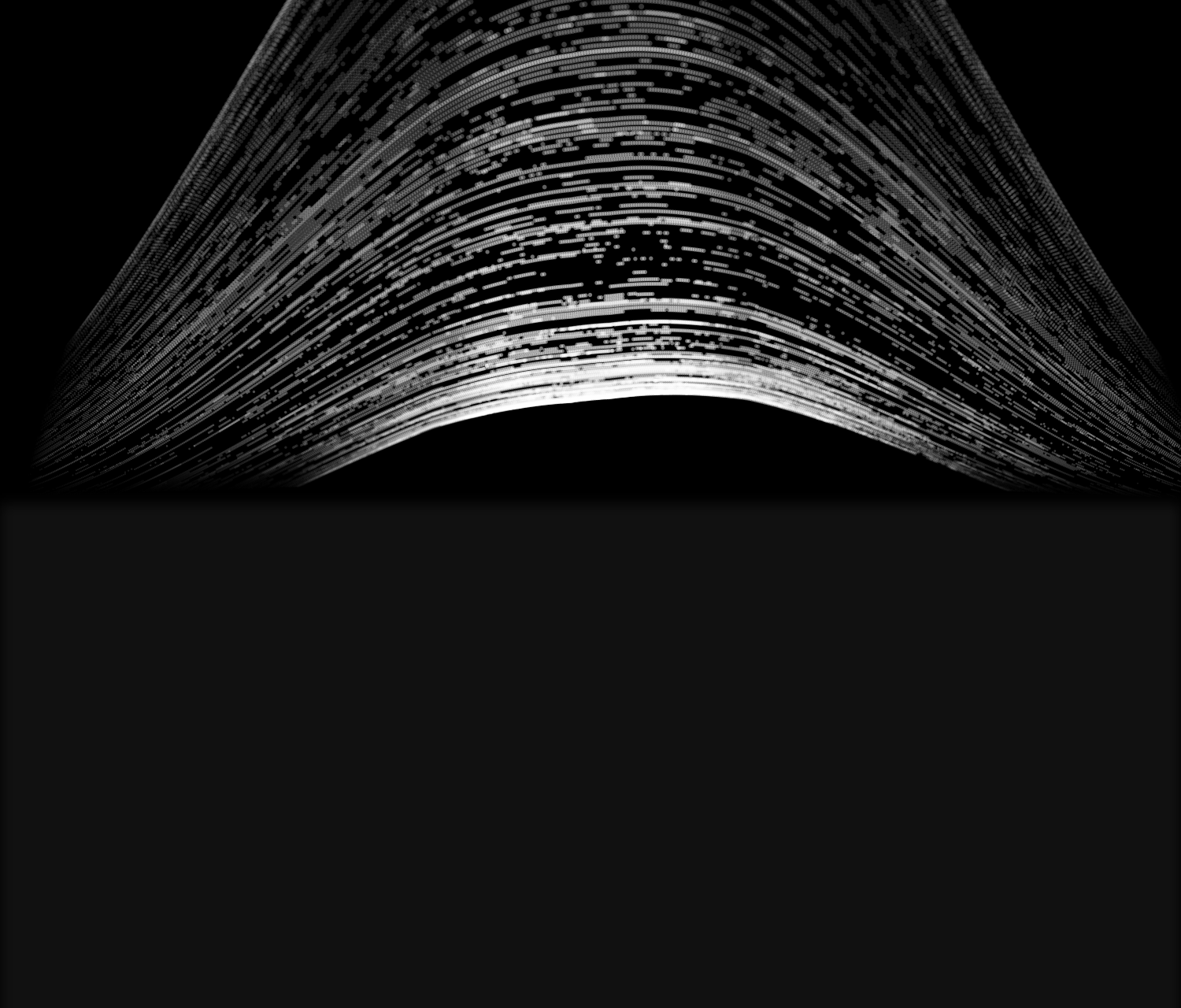
Summer Solstice 2016-Summer Solstice 2017
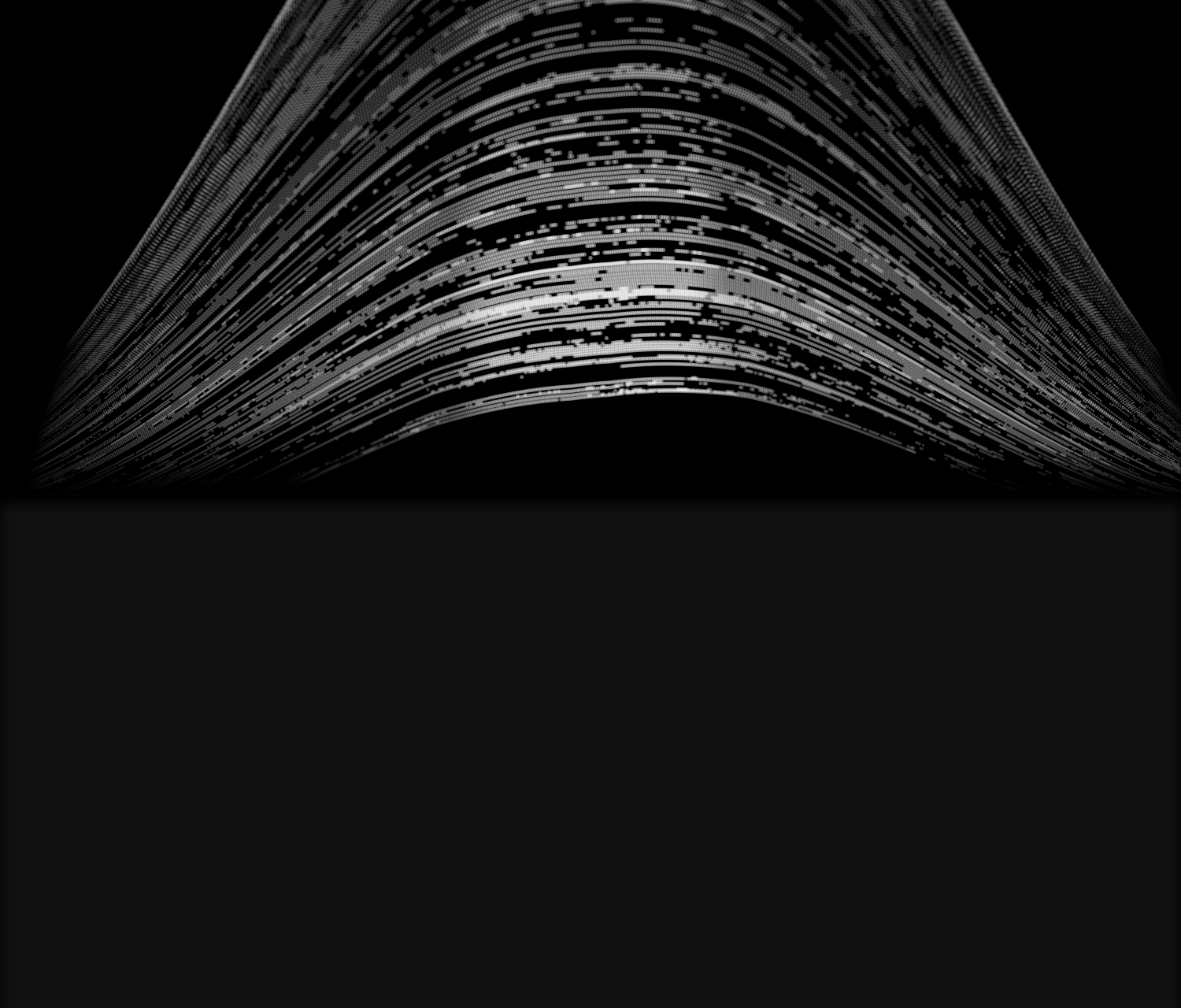
Summer Solstice 2017-Summer Solstice 2018
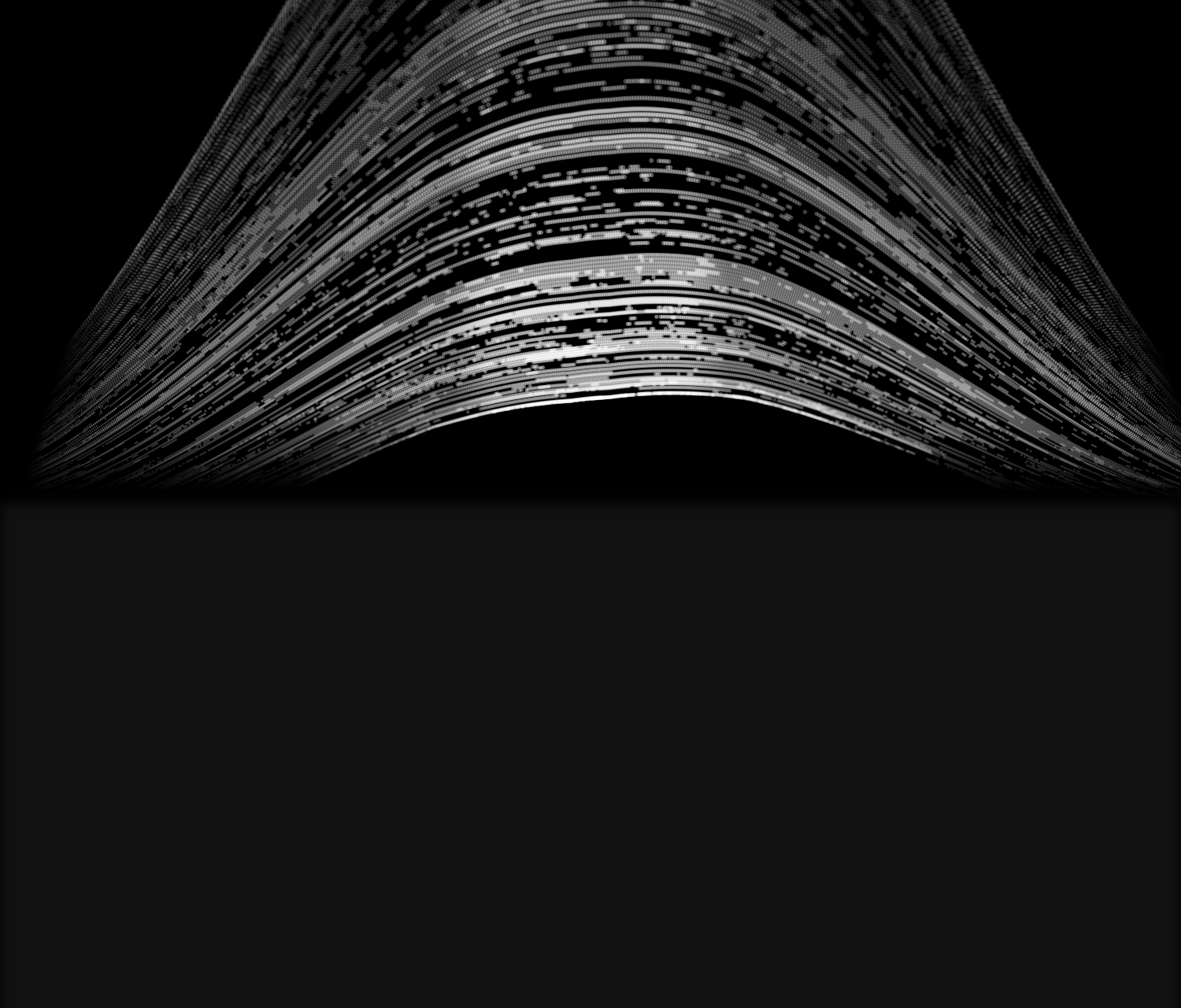
Summer Solstice 2018-Summer Solstice 2019
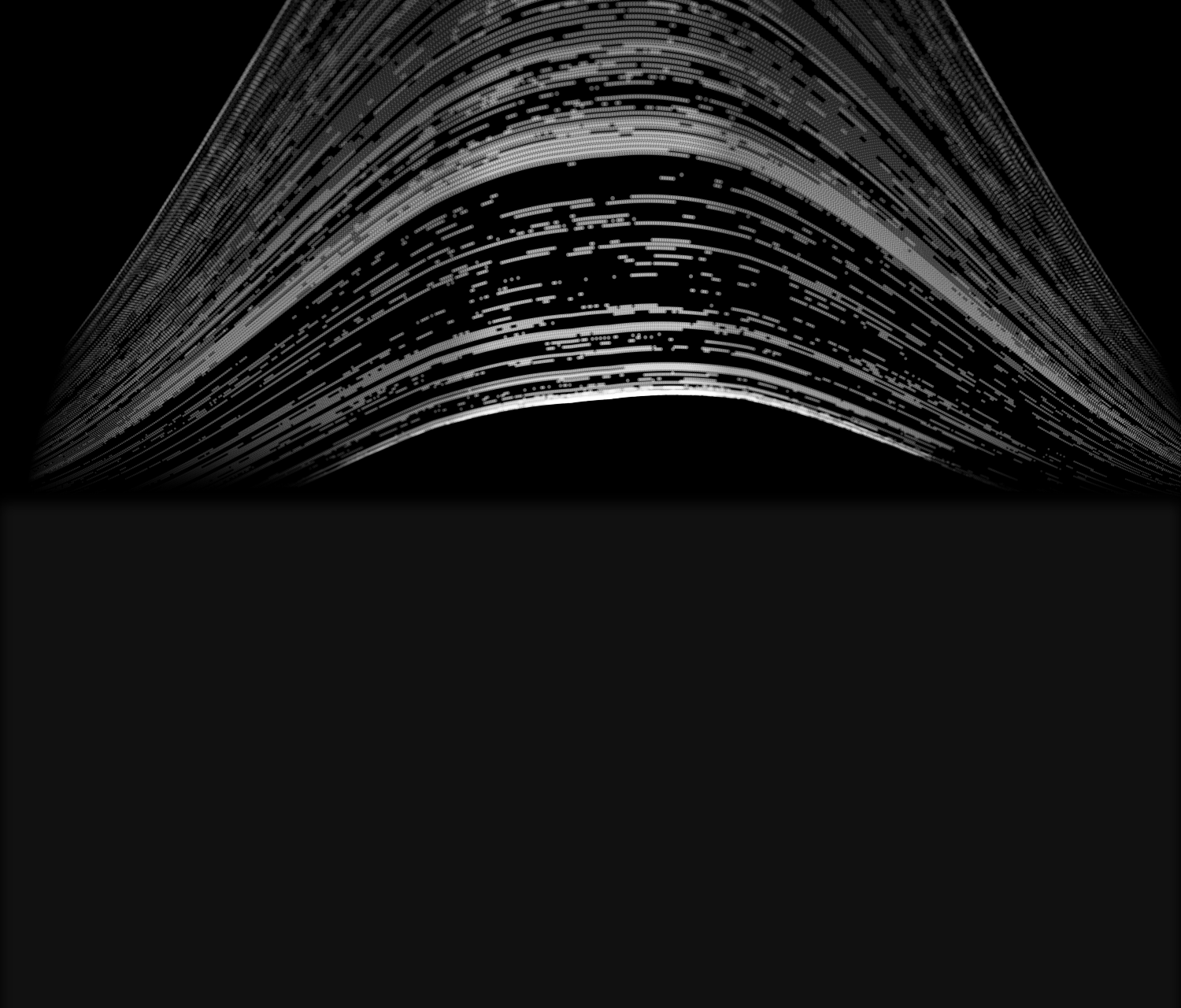
Summer Solstice 2019-Summer Solstice 2020
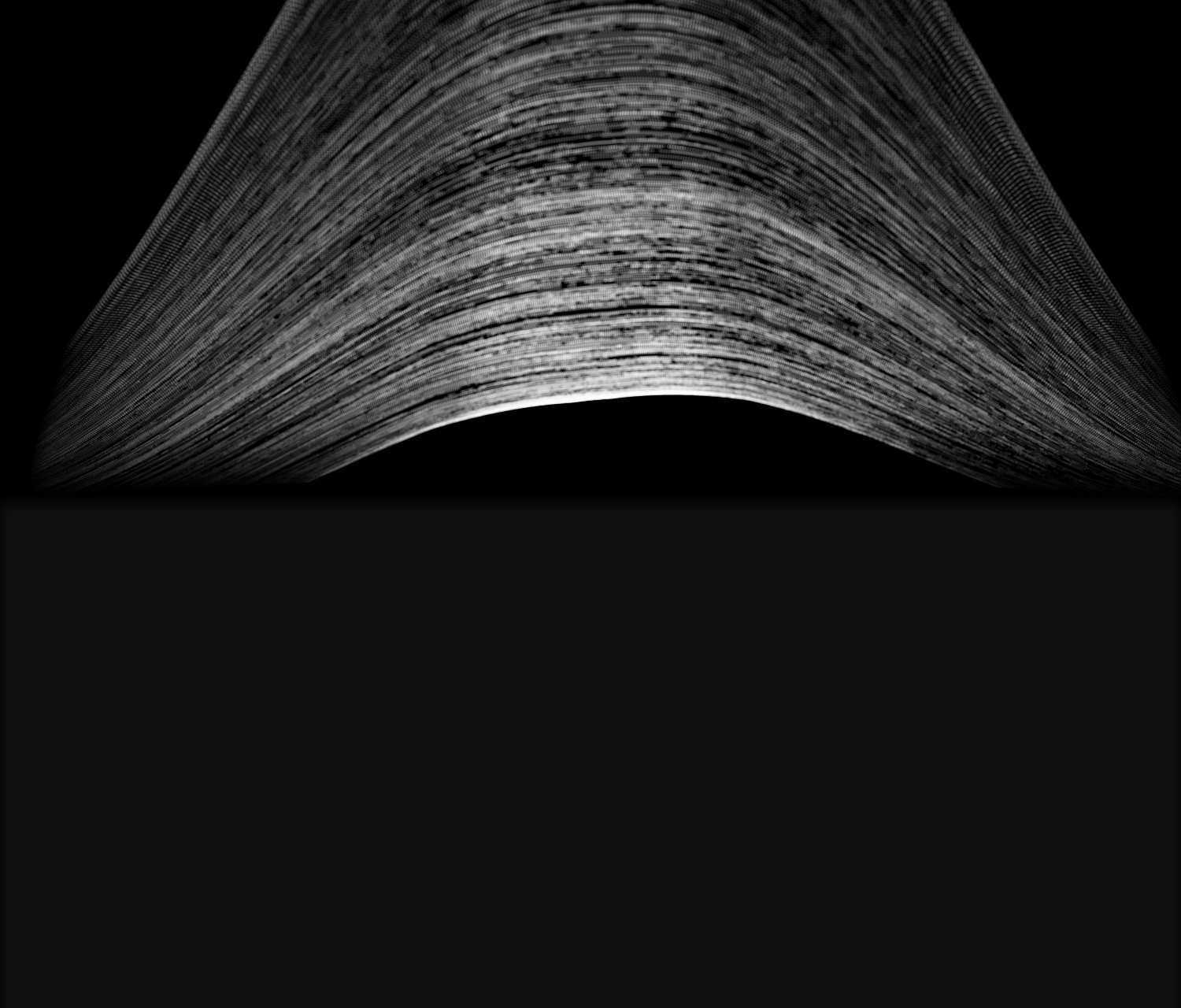
First 4 years worth of pyranometer data combined into one image.
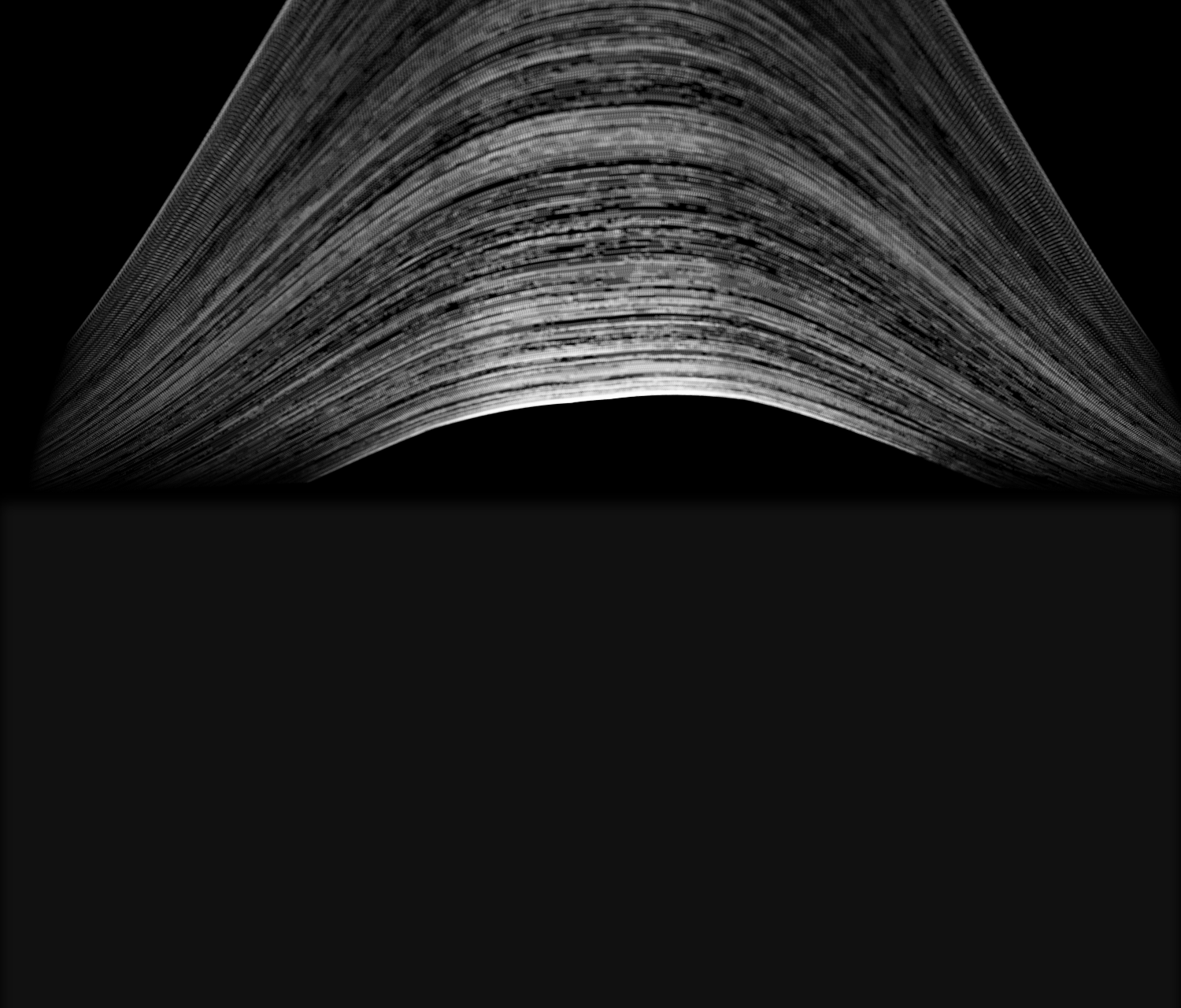
Last 4 years worth of pyranometer data combined into one image.
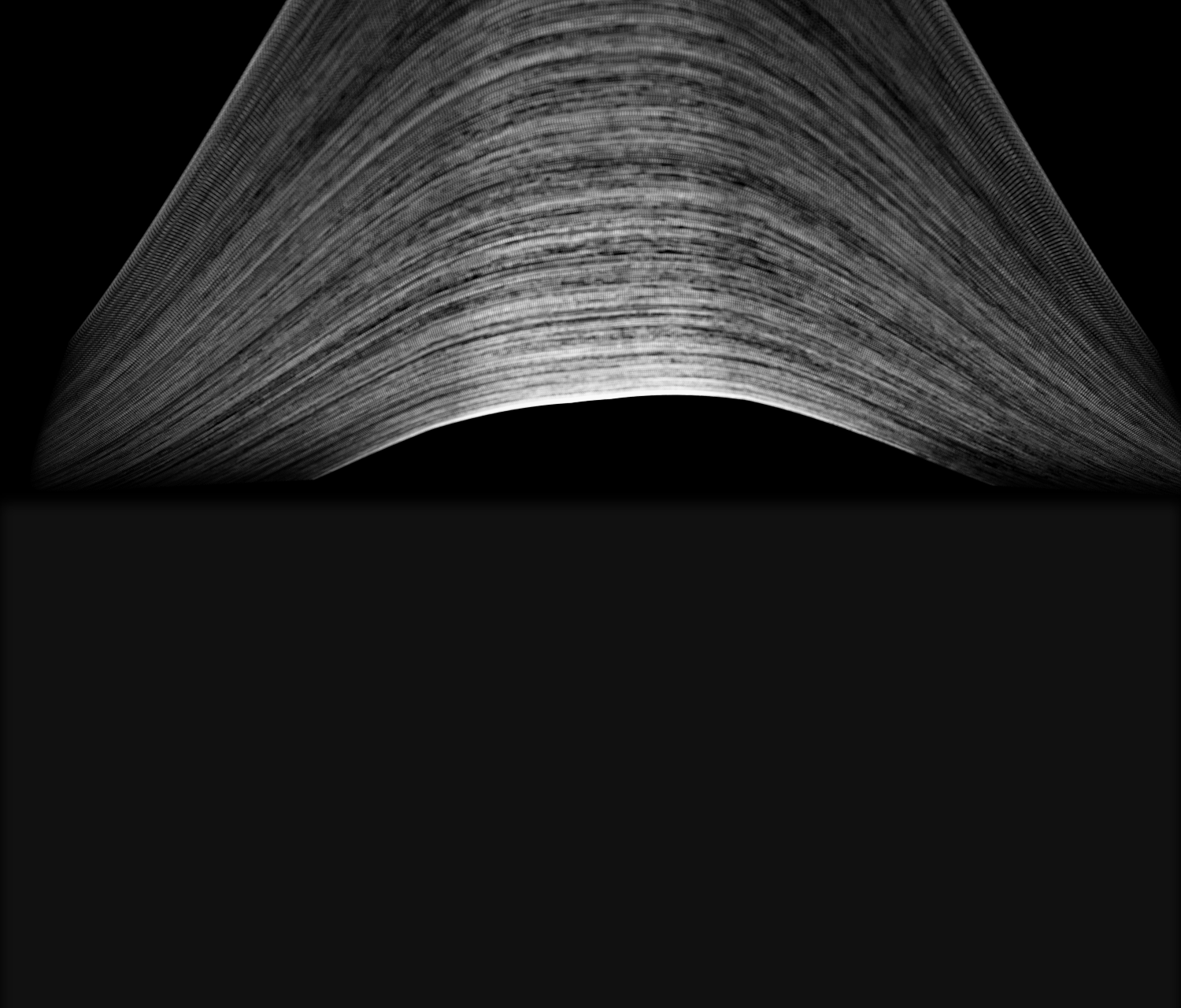
All 8 years worth of pyranometer data combined into one image.
Comparing the physical pinhole image (top) to the pyranometer data from the combined eight years (bottom), striking similarities are obvious, but differences too. This would give credence to my initial thought that it did not record every single sun trail over the eight year period. Images such as these give us many answers but raise even more questions.
My question is, when and what happened to the silver over the years. Did it become inactive and at what point? Was the pinhole aperture blocked periodically?
However, the fact remains, it managed to capture the gantry which was not built until the last two years of the exposure. This means that it was still ‘recording’ the surroundings in the bottom part of the image, ie the grass and gantry, towards and probably right up until the end of the eight years.
“Does climate and latitude affect the outcome?”
Another reason why the sky is not totally filled with white lines after an eight year exposure could be because of latitude. This is the measurement of distance north or south of the Equator. As the Earth travels around the Sun, the hemisphere that is tilted towards or away from the Sun changes. The hemisphere that is tilted towards the Sun is warmer because sunlight travels more directly to the Earth's surface so less gets scattered in the atmosphere. The seasons are a result of the Earth's tilt. Throughout the year, different parts of Earth receive the Sun's most direct rays. When the North Pole tilts toward the Sun, it is summer in the Northern Hemisphere. And when the South Pole tilts toward the Sun, it is winter in the Northern Hemisphere. Places on or near the equator get more hours of sunlight and would therefore show more sun trails as opposed to our often gloomy Britain. Also, the latitude has an effect on the configuration of sun trails that are captured. In countries in the northern hemisphere, such as Alaska, the sun will not set or rise from equinox to equinox. In other words, the pole gets one sunrise and 1 sunset per year.
“The can which is placed over the Ilford photosensitive paper in the National Geographic article and the can that is attached to the dome is not the same one. Also, why is the can still shiny after it has been in the open for an extended time? It should be faded.”
The can in the image, placed over the Ilford paper, is the actual can used for the eight year exposure. The image of this same can when attached to the telescope dome was taken in 2013 at the start of the exposure, whilst it was wrapped in a weather proof plastic coat. This is the simple reason why all my cans remain ‘shiny’. I work from the UK, where the weather is not great. All my pinhole cans are wrapped in black plastic pond liner to protect them from the changing weather conditions. For those of us who are lucky enough to live and work closer to the equator this may not be a necessity. Spain for example, can average of 3000 hours of sunshine per year. Here in the UK this drops to only an average of only 1493 hours per year. Wrapping the cans so that they never come into contact with the elements stops the likelyhood of rain getting in and images getting damaged. As you can see in the images below, the can has retained its shine but is no longer in pristine condition. Mould has started to grow and where the aperture is, the aluminium has started to corrode.
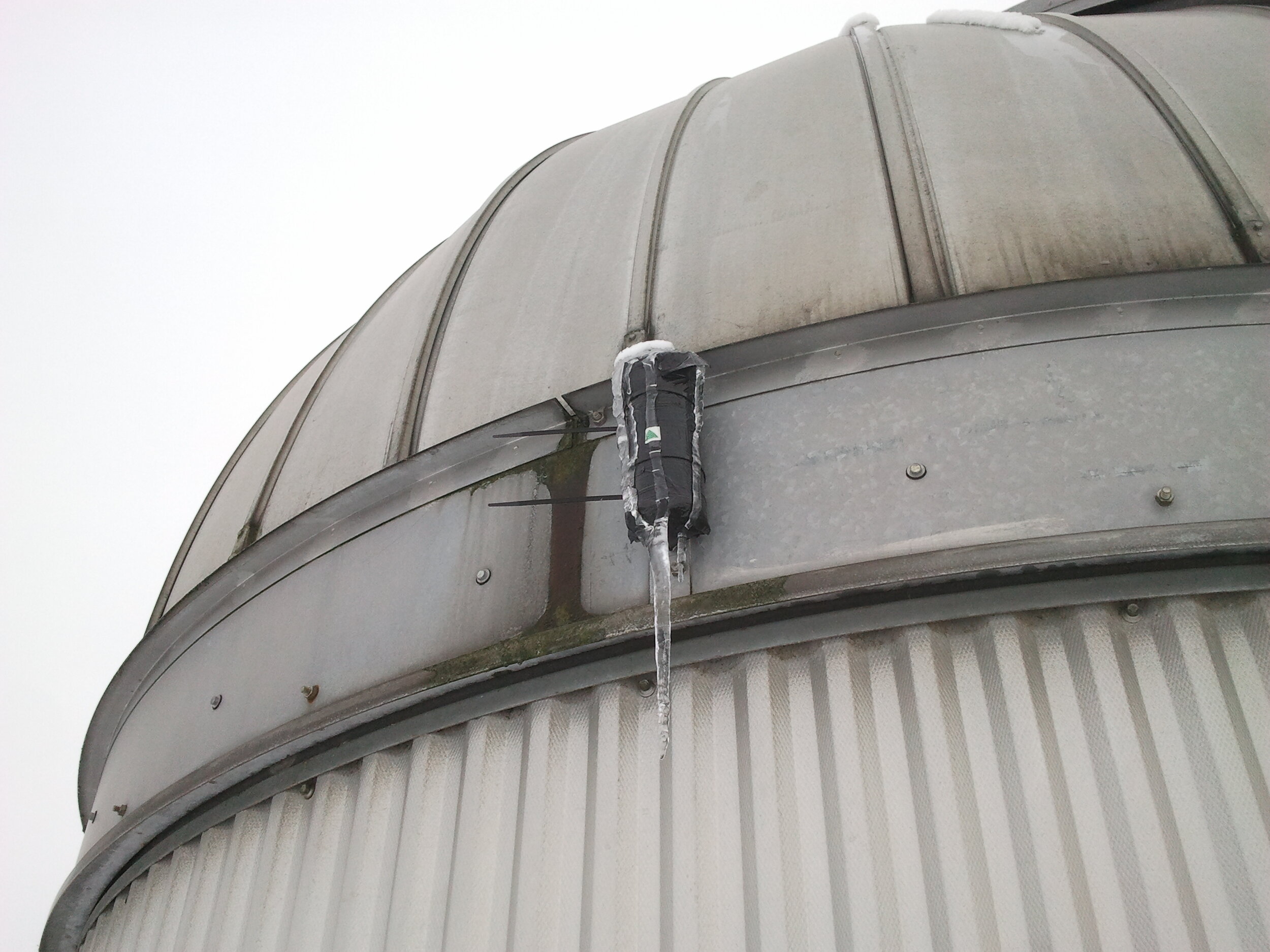

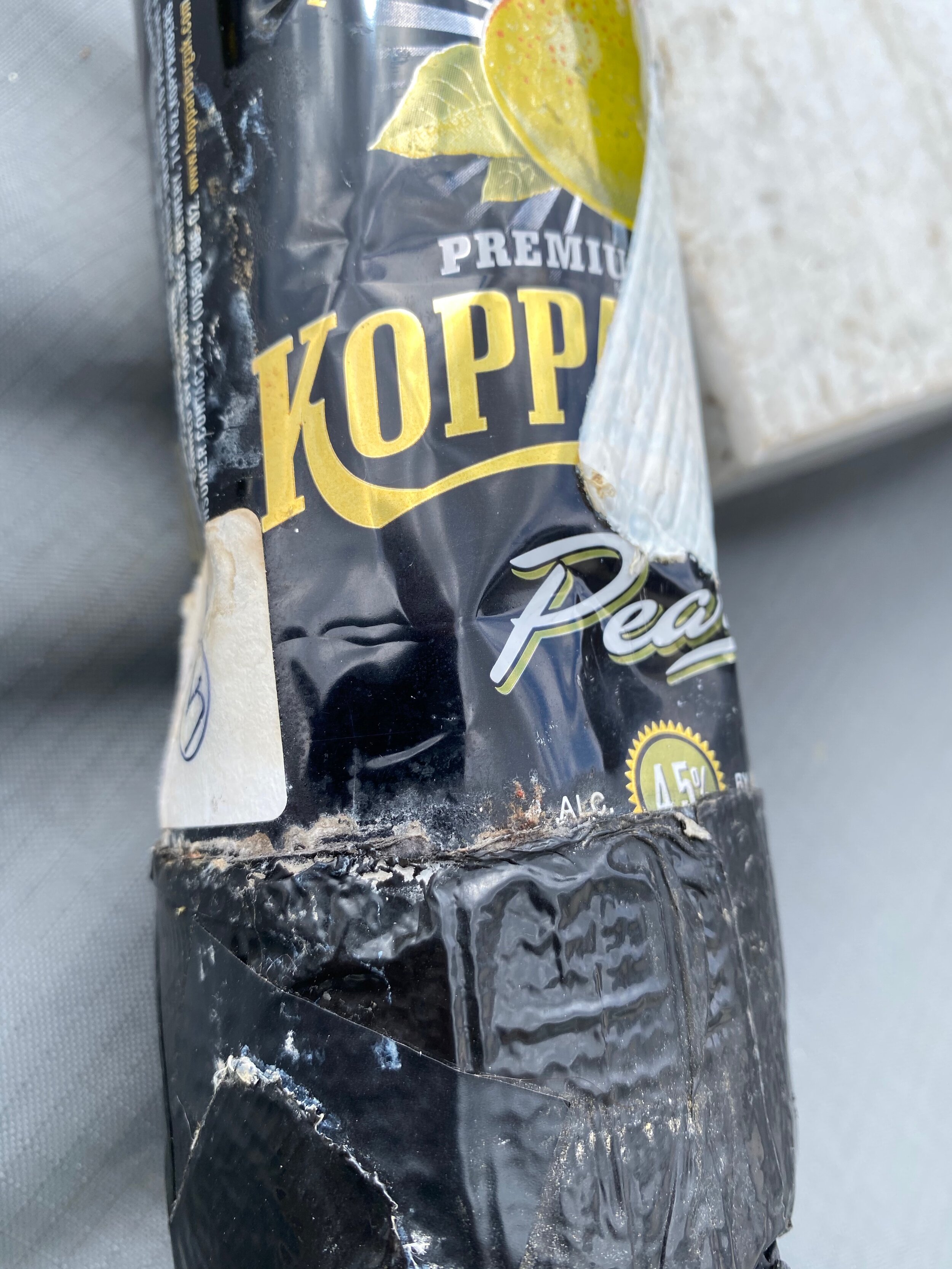
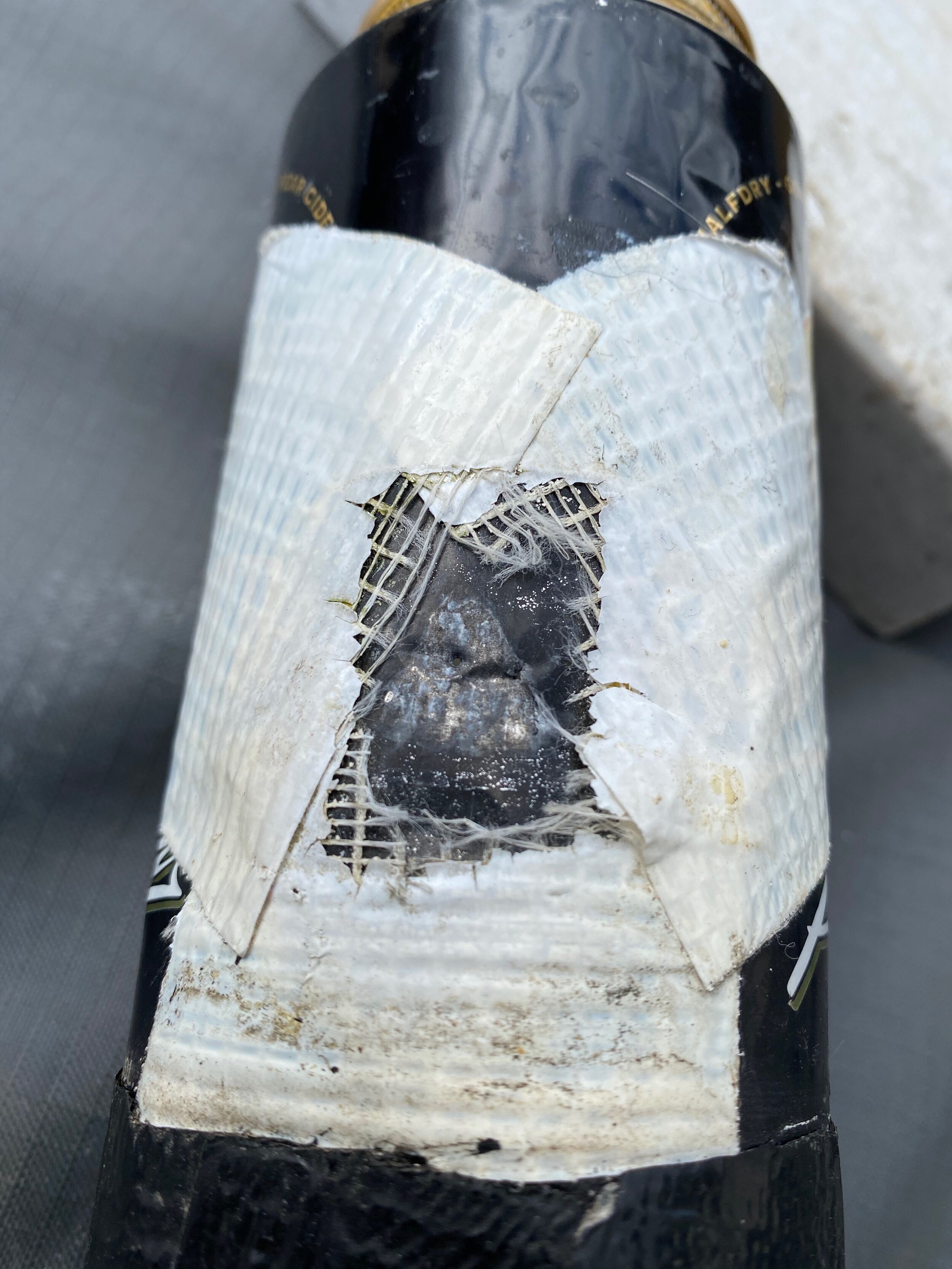
“It's unbelievable that it would turn out like this in eight years as you said in the National Geographic article: your other months-long attempts were ruined by moisture and the photosensitive paper wrinkled”.
The quote: ‘My other months long attempts were ruined by moisture and the photosensitive paper wrinkled’ was slightly rewritten by a reporter for the article. It became ambiguous and is now being taken out of context. What I said was misconstrued. To clarify: on this occasion (summer of 2012) I put up two cans on the telescope and after about 4 years we discovered that ‘one’ was ruined. There is only one light sensitive side to photographic paper and because it had curled up, the light entering was hitting the wrong side of the paper and left no image. Or the pinhole got covered by dirt. Also, the fact that the telescope was only revolving at night meant that no direct sunlight was entering the can. The can carried on facing North, it was not spinning as intended. These were not one-off pinhole cameras that I put up. Or a one-off image that I produced. As documented on this website, there have been many occasions over the years when I have put up several pinhole cameras, mostly successful and sometimes ruined. I always put up more cans to get different angles but also because they can go wrong when left unattended for long; moisture, mould, animals, vandals, people worried about black packages etc.
“Why did you suddenly decide to take it down?”
The second pinhole camera stayed up until the 16th of September 2020. It was there, not doing any harm, half forgotten but finally got in the way when David had to attach some solar panels to the exact spot where the camera had been attached.
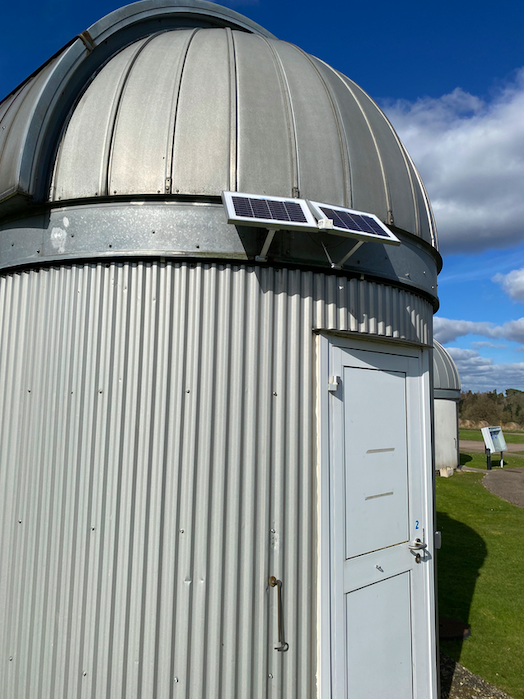
The pinhole camera was removed to make way for the solar panels.
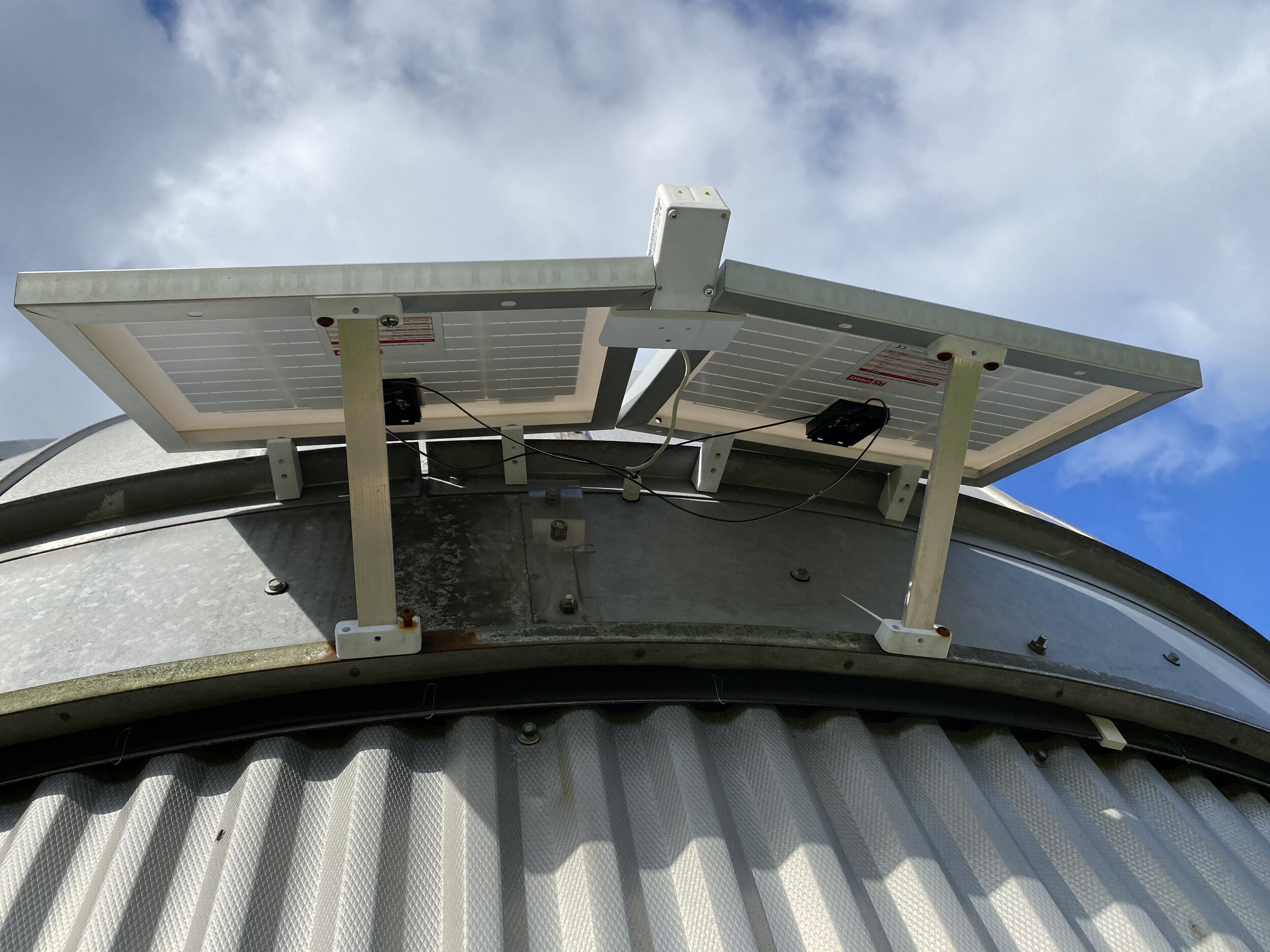
The perspex strip to which the camera was attached is still visible underneath.
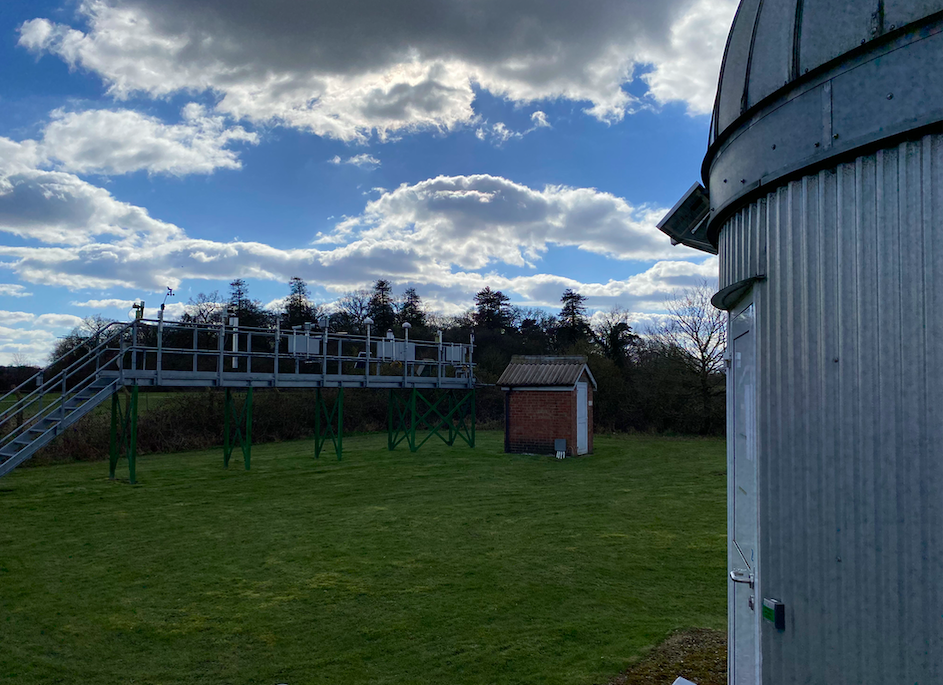
The view over the gantry from the solar panel and previously the position of the camera.
“Why is your image so blurry?”
‘Pinhole cameras don’t have to be focused like ordinary cameras, everything is always in focus. However, if you bring a pinhole camera very close to the object you are effectively increasing the size of the pinhole and the image will become blurred. A bigger pinhole will allow more light to get in and so the image will become brighter, but it will also be blurred as the next diagram shows. This is because light from one point on the object can reach more than one point on the screen’.
Due to pinhole’s incredible depth of field, everything is in focus. Getting an image is easy. Getting a perfectly sharp image is harder. I use sewing needles to prick holes in the aluminium cans whereas other photographers may work out the size of the hole in accordance to focal distance from pinhole aperture to paper negative at the back of the can.
Size matters.
It is very possible that my pinhole can suffered from what is called ‘diffraction’, which could result in a blur. This is when the light photons entering the pinhole aperture are affected by the contact edges of the aperture hole itself. Which is why a pinhole aperture in a thick metal does not work. Aluminium drinks cans are very thin and give the best results. A pinhole aperture which is too small can give a blurry image. And a pinhole aperture which is too large will also give a blurry image.
Below are cropped details from ‘Days in the Sun’ and ‘Perpetuity’. These were taken with different pinhole cans so they had different size pinhole apertures because I just make holes with a needle. They are never the same size and size will affect the sharpness of the image.
“In your publicity image, you are holding another camera to the one featured in the National Geographic (placed over the Ilford paper) and the one attached to the dome”.
The simple explanation for this is that when the story about the eight year exposure broke, December 2020, the country was in full lockdown due to the Covid pandemic. A publicity photograph of me was requested for the article and they were happy with an old image of myself at the Observatory holding a pinhole camera. This was originally the publicity image that went with the six month exposure ‘Days in the Sun’ which ended up on NASA’s A Picture of the Day (APOD). Images of domes and cans were used not as ‘proof’ but simply as documentation for people who have no concept of pinhole photography to understand the process.









